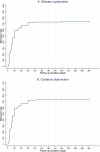Self-reported olfactory and gustatory dysfunctions in COVID-19 patients: a 1-year follow-up study in Foggia district, Italy
- PMID: 35065619
- PMCID: PMC8783175
- DOI: 10.1186/s12879-022-07052-8
Self-reported olfactory and gustatory dysfunctions in COVID-19 patients: a 1-year follow-up study in Foggia district, Italy
Abstract
Background: From the initial stages of the pandemic in early 2020, COVID-19-related olfactory and gustatory dysfunctions have been widely reported and are emerging as one of the most frequent long-term sequelae of SARS-CoV-2 infection. However, data regarding the long-term recovery of the sense of smell and taste are lacking. This study aimed to characterize the evolution up to one year after the diagnosis of self-reported olfactory and gustatory dysfunctions in COVID-19 cases.
Methods: Based on the data of the active surveillance platform of the Apulia region, Italy, we selected the residents of Foggia district who were confirmed positive for SARS-CoV-2 from March 1st to June 16th, 2020, and home-quarantined with paucisymptomatic-to-mild clinical presentation. Self-reported olfactory and gustatory dysfunctions were recorded at baseline through a survey of dichotomous questions. The evolution of these symptoms at approximately one year was prospectively assessed via telephone by the validated sino-nasal outcome test 22 (SNOT-22, Italian version).
Results: Among the 1,175 COVID-19 cases notified in the Foggia district during the first epidemic wave, 488 had paucisymptomatic-to-mild clinical presentation. Of these, 41.2% (n = 201, 95% confidence interval [CI] 36.8-45.7%) reported at least one sensory dysfunction. A total of 178 to 201 (88.5%) patients agreed to participate in the follow-up survey. According to the SNOT-22 results, the persistence of a sensory dysfunction was observed in the 29.8% (n = 53, 95% CI 23.2-37.1%) of them. Particularly, loss of smell persisted in 25.8% (n = 46, 95% CI 19.6-32.9%), loss of taste in 21.3% (n = 38, 95% CI 15.6-28.1%), loss of both in 17.4% (n = 31, 95% CI 12.2-23.8%) of participants in the follow-up. The rates of full recovery increased over time: from 59% at 30 days to 71.9% at 90 days for the sense of smell; from 61.3% at 30 days to 74.7% at 90 days for the sense of taste.
Conclusions: The persistence of COVID-19-related olfactory and gustatory dysfunctions up to 12 months after the disease onset in a noteworthy proportion (approximately 3 out of 10) of patients with paucisymptomatic-to-mild clinical presentation deserves further investigations due to its possible pathophysiological implications and impact on the quality of life.
Keywords: Ageusia; Anosmia; COVID-19; Long COVID, Italy; Prevalence; Recovery; Sensory dysfunctions.
© 2022. The Author(s).
Conflict of interest statement
The authors declare no competing interests.
Figures


Similar articles
-
Recovery from olfactory and gustatory dysfunction following COVID-19 acquired during Omicron BA.1 wave in Italy.Am J Otolaryngol. 2023 Sep-Oct;44(5):103944. doi: 10.1016/j.amjoto.2023.103944. Epub 2023 Jun 8. Am J Otolaryngol. 2023. PMID: 37354725 Free PMC article.
-
Olfactory and gustatory dysfunctions as a clinical presentation of mild-to-moderate forms of the coronavirus disease (COVID-19): a multicenter European study.Eur Arch Otorhinolaryngol. 2020 Aug;277(8):2251-2261. doi: 10.1007/s00405-020-05965-1. Epub 2020 Apr 6. Eur Arch Otorhinolaryngol. 2020. PMID: 32253535 Free PMC article.
-
[Incidence and prognosis of olfactory and gustatory dysfunctions related to infection of SARS-CoV-2 Omicron strain: a national multi-center survey of 35 566 population].Zhonghua Er Bi Yan Hou Tou Jing Wai Ke Za Zhi. 2023 Jun 7;58(6):579-588. doi: 10.3760/cma.j.cn115330-20230316-00117. Zhonghua Er Bi Yan Hou Tou Jing Wai Ke Za Zhi. 2023. PMID: 37339898 Chinese.
-
Olfactory and gustatory dysfunctions due to the coronavirus disease (COVID-19): a review of current evidence.Eur Arch Otorhinolaryngol. 2021 Feb;278(2):307-312. doi: 10.1007/s00405-020-06120-6. Epub 2020 Jun 17. Eur Arch Otorhinolaryngol. 2021. PMID: 32556781 Free PMC article. Review.
-
Olfactory and Gustatory Recovery Time Evaluation of COVID-19: A Systematic Review and Meta-Analysis.Acta Med Indones. 2025 Jan;57(1):18-43. Acta Med Indones. 2025. PMID: 40263685
Cited by
-
Evaluation of children and adults with post-COVID-19 persistent smell, taste and trigeminal chemosensory disorders: A hospital based study.World J Clin Pediatr. 2023 Jun 9;12(3):133-150. doi: 10.5409/wjcp.v12.i3.133. eCollection 2023 Jun 9. World J Clin Pediatr. 2023. PMID: 37342446 Free PMC article.
-
Central Nervous System Manifestations of Long COVID: A Systematic Review.Cureus. 2025 Apr 30;17(4):e83247. doi: 10.7759/cureus.83247. eCollection 2025 Apr. Cureus. 2025. PMID: 40453253 Free PMC article. Review.
-
Oral Manifestations in the Post COVID-19 Condition: A Systematic Review With Meta-Analysis.Rev Med Virol. 2025 Jul;35(4):e70057. doi: 10.1002/rmv.70057. Rev Med Virol. 2025. PMID: 40663038 Free PMC article. Review.
-
Long Covid: where we stand and challenges ahead.Cell Death Differ. 2022 Oct;29(10):1891-1900. doi: 10.1038/s41418-022-01052-6. Epub 2022 Sep 7. Cell Death Differ. 2022. PMID: 36071155 Free PMC article. Review.
-
One-year psychophysical evaluation of COVID-19-induced olfactory disorders: a prospective cohort study.BMC Med. 2023 Dec 8;21(1):490. doi: 10.1186/s12916-023-03205-x. BMC Med. 2023. PMID: 38066629 Free PMC article.
References
-
- American Academy of Otolaryngology-Head and Neck Surgery. Anosmia, hyposmia, and dysgeusia symptoms of Coronavirus Disease. 2020. https://www.entnet.org/content/aao-hns-anosmia-hyposmia-and-dysgeusia-sy.... Accessed 10 Jun 2021.
-
- Centers for Disease Control and Prevention (CDC). Coronavirus disease 2019 (COVID-19)-symptoms. 2020. https://www.cdc.gov/coronavirus/2019-ncov/symptoms-testing/symptoms.html. Accessed 10 Jun 2021.
-
- European Centre for Disease Prevention and Control (ECDC). Case definition for coronavirus disease 2019 (COVID-19), as of 3 December 2020. https://www.ecdc.europa.eu/en/covid-19/surveillance/case-definition. Accessed 10 Jun 2021.
-
- Villerabel C, Makinson A, Jaussent A, Picot MC, Nègre-Pagè L, Rouvière JA, et al. Diagnostic value of patient-reported and clinically tested olfactory dysfunction in a population screened for COVID-19. JAMA Otolaryngol Head Neck Surg. 2021;147:271–279. doi: 10.1001/jamaoto.2020.5074. - DOI - PMC - PubMed
MeSH terms
LinkOut - more resources
Full Text Sources
Medical
Miscellaneous

